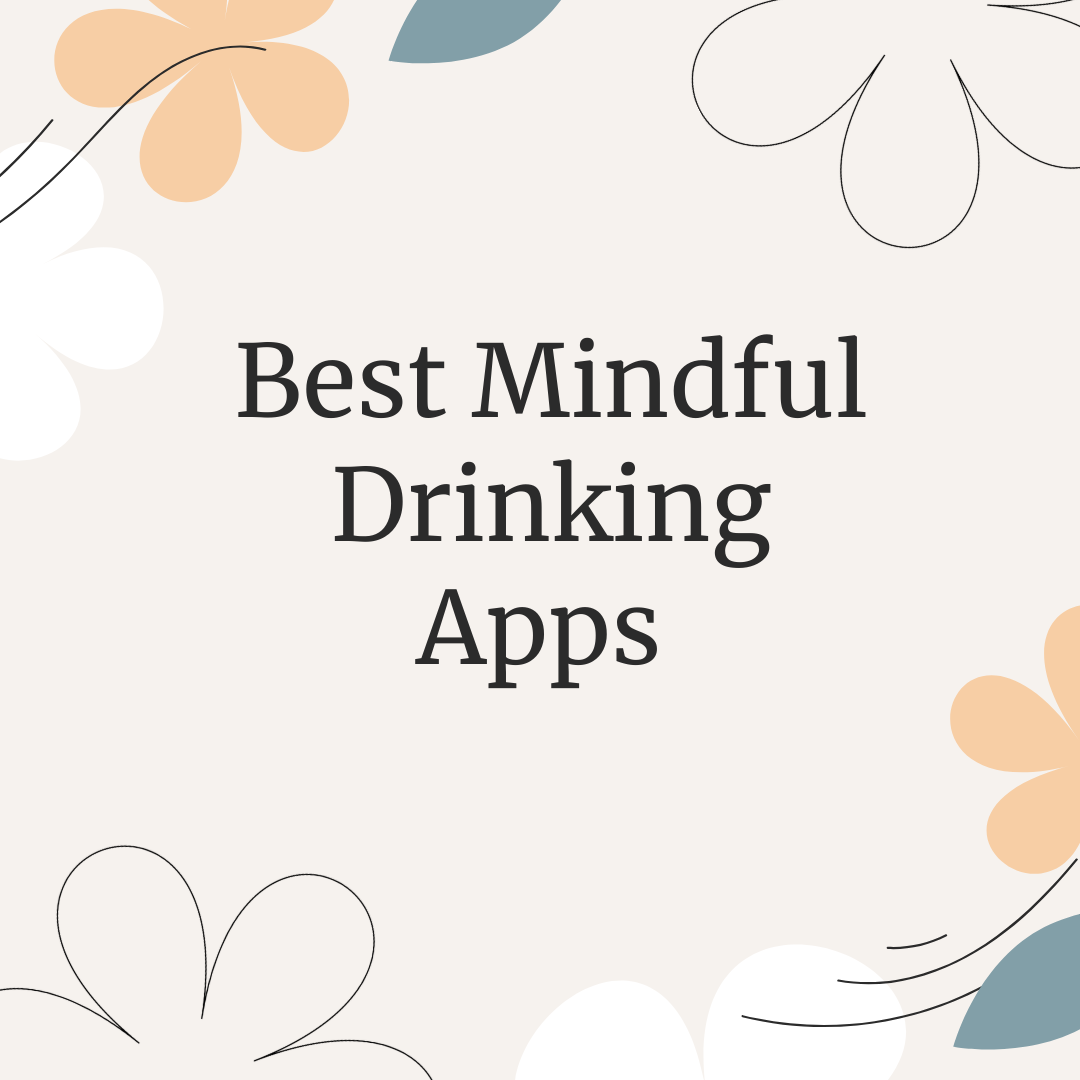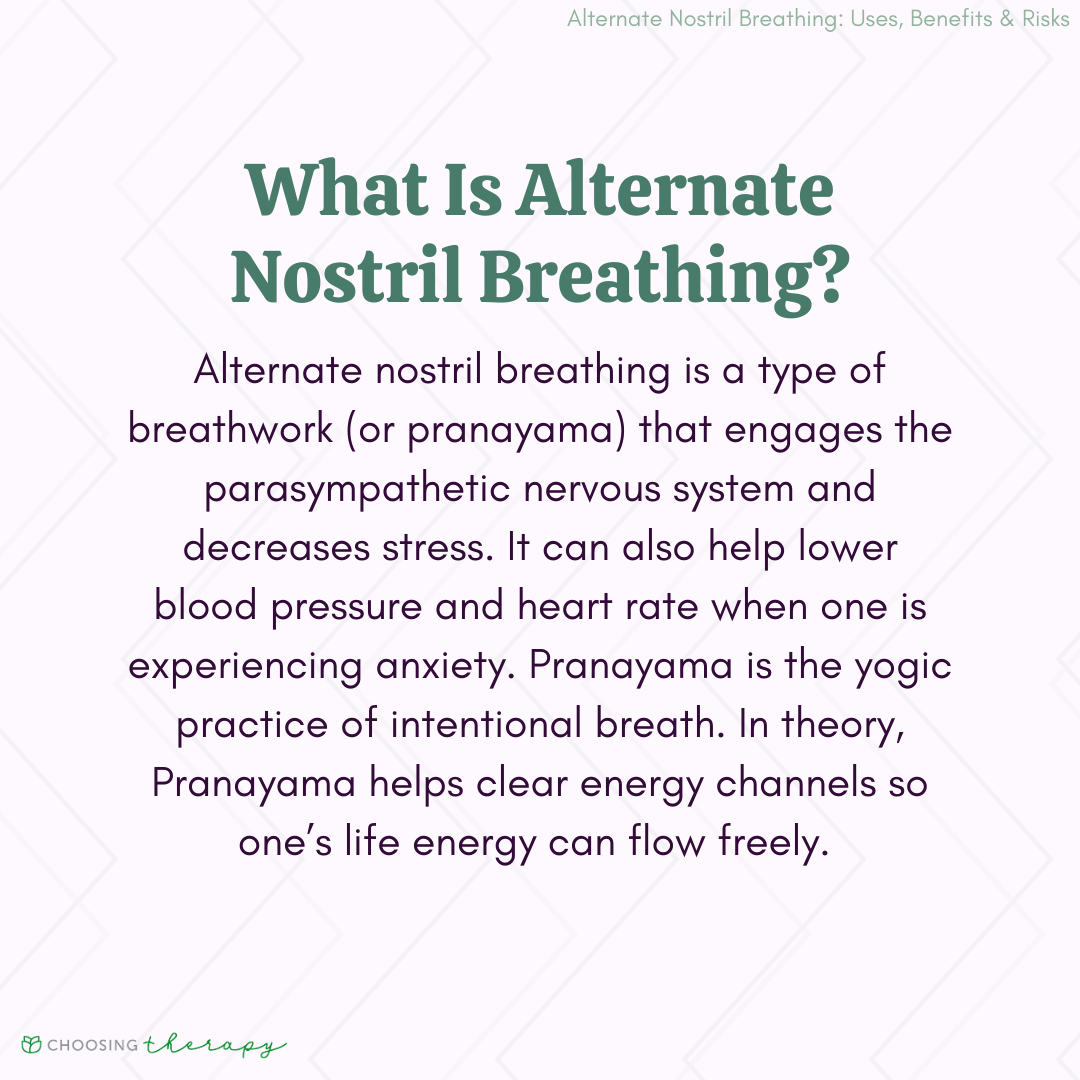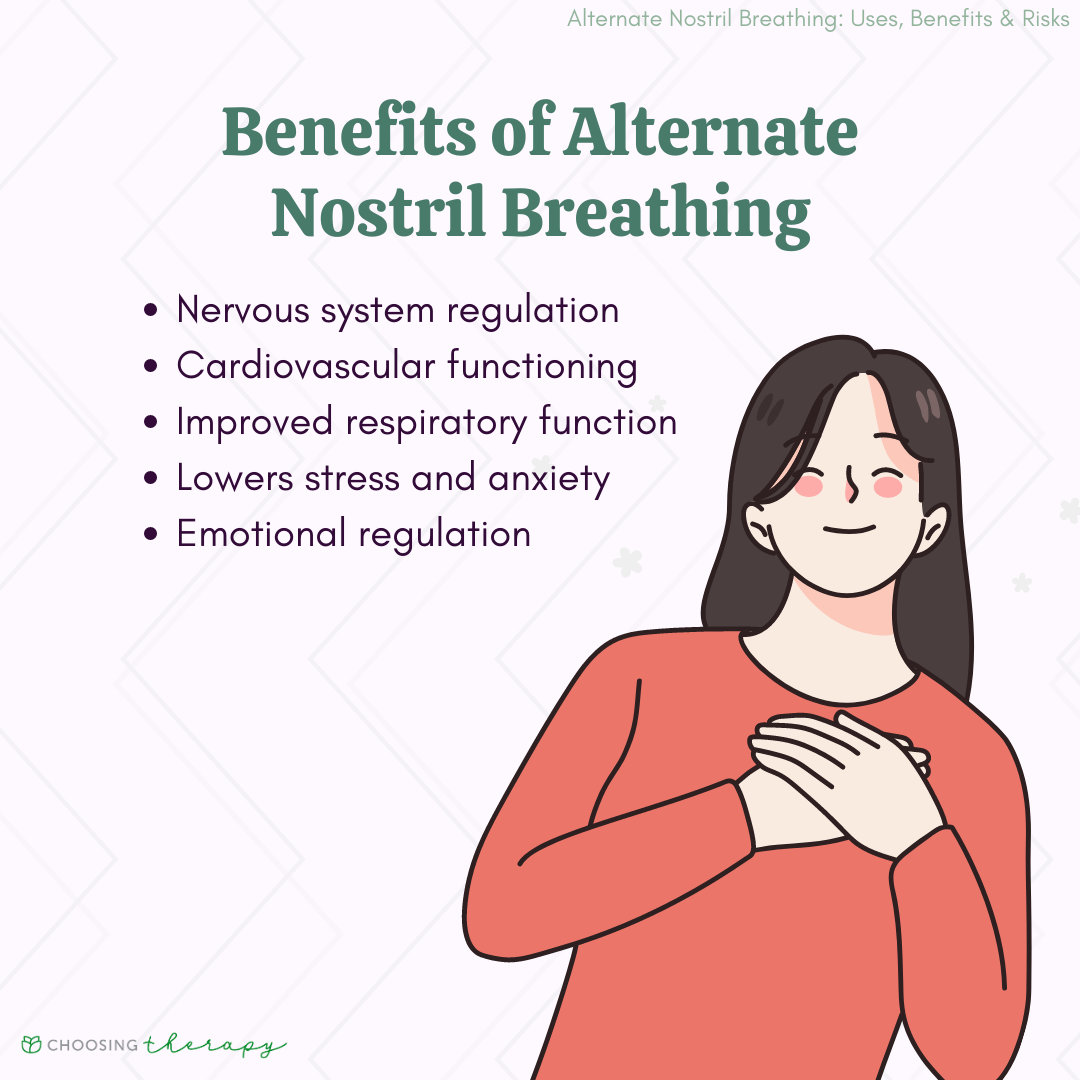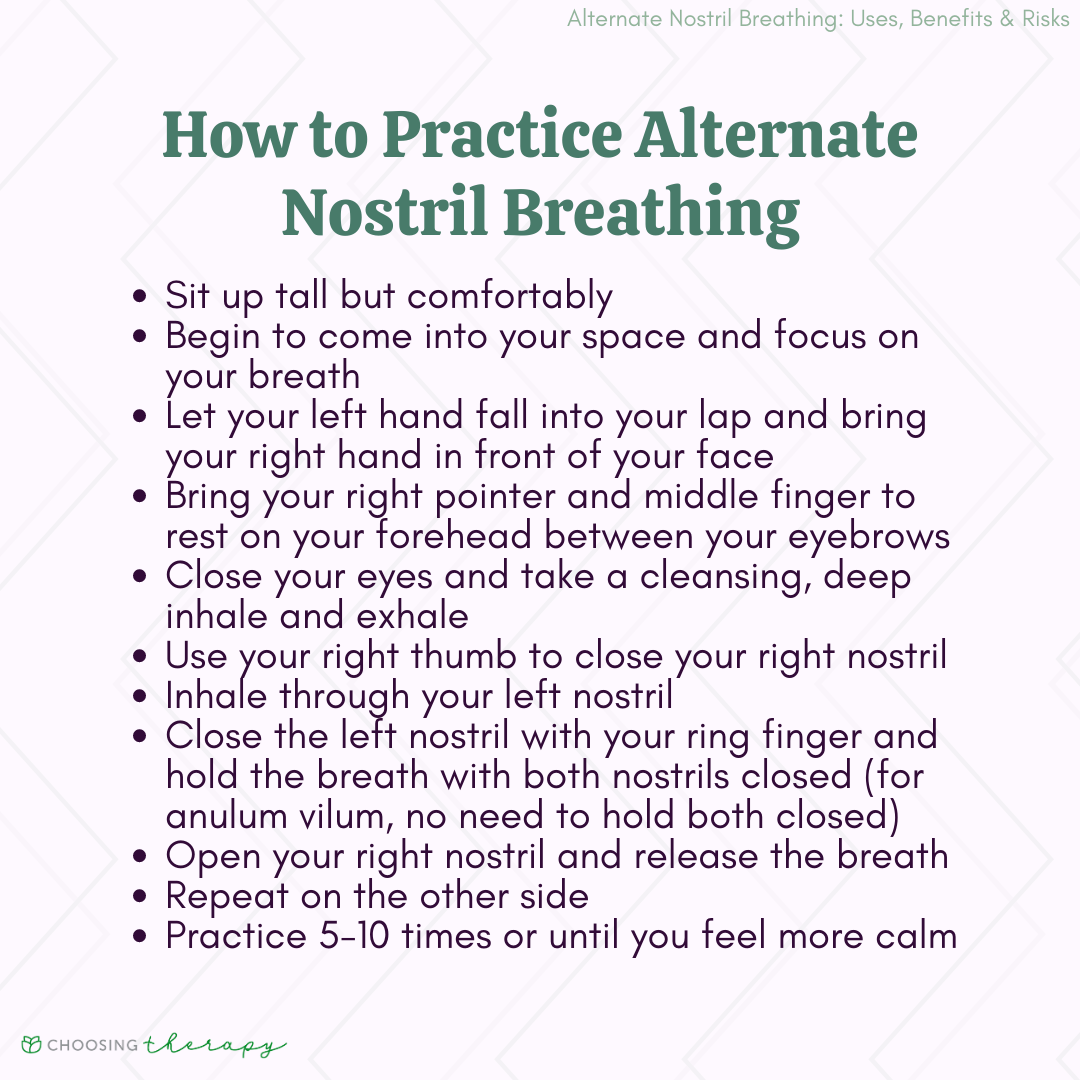
Alternate nostril breathing, also known as Nadi Shodhana, is an ancient yogic breathing exercise used to help one manage stress and anxiety. When practiced, a person breathes through one nostril while holding the other closed. Alternate nostril breathing can also be incorporated into a meditation routine, as it relaxes the body and mind.
Would you like to learn mindfulness? Therapy is a great place to master self-awareness and mindfulness. BetterHelp has over 20,000 licensed therapists who provide convenient and affordable online therapy. BetterHelp starts at $65 per week. Take a Free Online Assessment and get matched with the right therapist for you.
What Is Alternate Nostril Breathing?
Alternate nostril breathing is a type of breathwork (or pranayama) that engages the parasympathetic nervous system and decreases stress. It can also help lower blood pressure and heart rate when one is experiencing anxiety.
Pranayama is the yogic practice of intentional breath, which translates to “vital life force” in Sanskrit.1 In theory, Pranayama helps clear energy channels so one’s life energy can flow freely.
Common types of alternate nostril breathing techniques include:
- Nadi shodhana: This entails inhaling through one nostril, holding the breath, and exhaling out of the other nostril. In nadi shodhana, one uses their hands to physically close off one nostril while inhaling and exhaling.
- Anulom vilom: With this method, one will consciously inhale through one nostril and exhale out the other.
Practices That Include Alternate Nostril Breathing
Alternate nostril breathing is used in many different practices to promote relaxation. One may see this exercise used in yoga, guided meditations, or even therapy. Adding alternate nostril breathwork into a daily routine can help a person feel more grounded, decrease stress, or improve sleep quality.
Common practices that use alternate nostril breathing include:
- Breathwork
- Meditation
- Mindfulness
- Yoga for anxiety
- Progressive muscle relaxation
- Mindfulness-based stress reduction (MBSR)
- Tai Chi
- Hatha yoga
Benefits of Alternate Nostril Breathing
When focusing on controlling the rate and depth of one’s breath, a person is practicing mindfulness. Mindfulness is the act of being present and aware in a moment and viewing one’s current experiences without judgment. This can help ease a person’s mental anxieties caused by stress.
However, stress also results in negative effects on one’s physical functioning. Alternate nostril breathing helps balance the right and left hemispheres of the brain, as well as manage or improve symptoms of certain health conditions.
Benefits of alternate nostril breathing include:
Nervous System Regulation
The autonomic nervous system (ANS) controls many of the body’s automatic functions. When there is a real or perceived threat, a person’s ANS increases their breathing, blood pressure, and heart rate. Alternate nostril breathing calms the nervous system and triggers the relaxation response, as it works by engaging the vagus nerve–b
Alternate nostril breathing may improve nervous system functioning by:
- Stimulating the vagus nerve: When stimulated, the vagus nerve engages the body’s relaxation response, producing a sense of calm.
- Regulating the amygdala: The amygdala is responsible for emotional responses. Alternate nostril breathing can help regulate this area of the brain.3
- Balancing neurotransmitters: The locus coeruleus area of the brain produces norepinephrine.2 By practicing alternate nostril breathing, the balance of norepinephrine in the brain may be balanced.
Cardiovascular Functioning
Alternate nostril breathing may decrease a person’s risk for developing a cardiovascular disease, and also improve conditions such as diabetes type 2, high cortisol, and hypertension.4 The more one practices this exercise, the less likely they are to become overwhelmed by their stress response, which can positively impact their heart rate and blood pressure.
Some cardiovascular benefits of alternate nostril breathing include:
- Lowers heart rate
- Lowers blood pressure
- Increases oxygen in the blood
Improved Respiratory Function
Alternate nostril breathing can improve lung functioning and help one breathe more efficiently. One study found that regular practice resulted in positive outcomes for both the participants’ autonomic and cardiopulmonary systems.5 Deep breathing can clear mucus in the lungs to help one breathe better, as well as improve lung capacity and strength. Alternate nostril breathing is also beneficial for those managing COPD.
Lowers Stress & Anxiety
As mentioned, alternate nostril breathing engages the parasympathetic nervous system, which alleviates anxiety resulting from “fight or flight” responses. Practicing this routinely builds up a resilience to stress over time as one widens their “window of tolerance.”
Alternate nostril breathing is also a form of mindfulness for anxiety and can be incorporated into a meditation for anxiety practice.
Emotional Regulation
Emotional regulation is a term that refers to how a person manages their emotions during intense or overwhelming moments. Practicing alternate nostril breathing brings one back to the present moment, and encourages them to ground their emotions before responding. This is a tool that can be used as a part of meditation for anger, mindfulness for borderline personality disorder, and other practices, as it helps one better navigate challenging emotions.
Options For Anxiety Treatment
Talk Therapy – Get help from a licensed therapist. Betterhelp offers online therapy starting at $65 per week. Free Assessment
Psychiatry for Anxiety – Looking for anxiety treatment that prioritizes you? Talkiatry can help. Find an in-network psychiatrist you can see online. Get started with our short assessment. Visit Talkiatry
Possible Risks of Alternate Nostril Breathing
Alternate nostril breathing is safe for most people, but there are some associated risks to be aware of. If a person has COPD or asthma, they should consult with their doctor before starting alternate nostril breathing. Feeling anxious or upset while practicing alternate nostril breathing may be a sign that one should seek guidance from their medical or mental health provider.
Potential side effects of alternate nostril breathing include:
- Nausea
- Vomiting
- Dizziness
- Fainting
- Shortness of breath
Is Alternate Nostril Breathing Safe?
Alternate nostril breathing is a well-researched and safe practice used to manage many mental and physical health conditions. Side effects are rare and usually only affect those who have medical conditions. Studies show significant positive outcomes for individuals who utilize alternate nostril breathing, particularly in the management of stress, anxiety, and fear.6
How to Prepare for Alternate Nostril Breathing
Although alternate nostril breathing can be performed anywhere, it can be helpful to use a guide when first starting out. You can also ask a yoga teacher to walk you through it or watch a video online. While this is a simple practice, it does involve more attention than simply “taking a deep breath.”
To prepare for an alternate nostril breathing exercise, you should:
- Sit in a comfortable position.
- Relax your jaw.
- Learn about mindfulness for beginners beforehand.
- Fix your gaze or close your eyes.
- Start by listening to a guided meditation to help you settle in.
How to Practice Alternate Nostril Breathing
Preparation is key when seeking to have the best experience possible with alternate nostril breathing. This can look different for everyone, but it’s important to find a space free of distractions where you can focus. You might want to play soft music, watch a video, or have a yoga teacher guide you.
Below is a step-by-step guide to practicing alternate nostril breathing:
- Sit up tall but comfortably (or choose another seated meditation pose).
- Begin to come into your space and focus on your breath.
- Let your left hand fall into your lap and bring your right hand in front of your face.
- Bring your right pointer and middle finger to rest on your forehead between your eyebrows.
- Close your eyes and take a cleansing, deep inhale, and exhale.
- Use your right thumb to close your right nostril.
- Inhale through your left nostril.
- Close the left nostril with your ring finger and hold your breath with both nostrils closed (for anulum vilum, you don’t need to hold both nostrils closed)
- Open your right nostril and release the breath.
- Repeat on the other side.
- Practice 5-10 times or until you feel calmer.
You can add or change some of these steps as needed to make the practice unique to you. Pay attention to how this breathing affects your mood and your body.
Professional Options for Alternate Nostril Breathing
Mindfulness has been practiced for centuries for anyone across the lifespan. Alternate nostril breathing can be used as a mindfulness technique for teens and for kids, as well. Breathwork is an easy way to remain grounded in the present moment when you’re feeling overwhelmed, no matter your age, location, or background.
Professional options to help you practice alternate nostril breathing include:
- Yoga teachers: Breathwork is an integral part of yoga and can be practiced alongside a yoga instructor.
- Mindfulness-based cognitive therapy (MBCT): MBCT includes both cognitive behavioral therapy and mindfulness, and focuses on helping people identify how their thoughts affect their emotions and behavior. Sessions may incorporate alternate nostril breathing.
- Respiratory therapists: These professionals are trained to work with individuals who have cardiopulmonary issues. They can teach you proper breathing techniques if you have a respiratory condition.
- Breathwork facilitators: Breathwork facilitators undergo extensive coursework and receive certification in breathing techniques, and can guide you through an alternate nostril breathing practice.
- Meditation teachers: These professionals have training in meditation and breathing, and can teach you how to integrate alternate nostril breathing into your routine.
Final Thoughts
Alternate nostril breathing is an easy, effective, and accessible way to improve your overall well-being. Practicing this can help you stay grounded and relaxed when feeling overwhelmed. You can start at any time, so consider incorporating alternate nostril breathing into your daily routine.
Additional Resources
To help our readers take the next step in their mental health journey, Choosing Therapy has partnered with leaders in mental health and wellness. Choosing Therapy is compensated for marketing by the companies included below.
Talk Therapy
Online-Therapy.com – Get support and guidance from a licensed therapist. Online-Therapy.com provides 45 minutes weekly video sessions and unlimited text messaging with your therapist for only $64/week. Get Started
Virtual Psychiatry
Hims / Hers If you’re living with anxiety or depression, finding the right medication match may make all the difference. Connect with a licensed healthcare provider in just 12 – 48 hours. Explore FDA-approved treatment options and get free shipping, if prescribed. No insurance required. Get Started
Anxiety Newsletter
A free newsletter from Choosing Therapy for those impacted by anxiety. Get helpful tips and the latest information. Sign Up
Learn Mindfulness, Meditation, & Relaxation Techniques
Mindfulness.com – Change your life by practicing mindfulness. In a few minutes a day, you can start developing mindfulness and meditation skills. Free Trial
Choosing Therapy Directory
You can search for therapists by specialty, experience, insurance, or price, and location. Find a therapist today.
Best Mindful Drinking Apps If you’re thinking about joining the sober curious movement and you’d like to cut back on drinking, mindful drinking apps are a great place to start. Practicing mindful drinking can take some time, attention, and patience, but with the help of the right app, you can completely transform your relationship with alcohol.
Best Online Therapy Services There are a number of factors to consider when trying to determine which online therapy platform is going to be the best fit for you. It’s important to be mindful of what each platform costs, the services they provide you with, their providers’ training and level of expertise, and several other important criteria.









